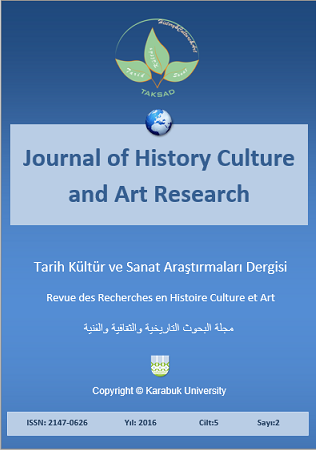<b>Postmodern Çağda Müslüman Tüketicilerin Gösterişçi Tüketim Davranışları Üzerine Mukayeseli Bir Çalışma</b> / <i>A Comparative Study on Conspicuous Consumption Behavior of muslim Consumers in the Postmodern Era</i>
DOI:
https://doi.org/10.7596/taksad.v5i2.532Keywords:
Consumer Behavior, Postmodern Consumption, Conspicuous Consumption, Consumer Society, Tüketici Davranışları, Postmodern Tüketim, Gösterişçi Tüketim, Tüketim ToplumuAbstract
A Comparative Study on Conspicuous Consumption Behavior of muslim Consumers in the Postmodern Era
Abstract
In traditional consumer behavior literature the purpose of consumption is explained as “the activities to meet the needs” and it is assumed that decisions of consumers based on benefit-cost analysis. But today objects are consumed not only for their utilitarian values but also for carrying some meanings. Nowadays consumers use objects to demonstrate the person that they want to be. Researchers explained that the purchase and consumption of goods can be self-enhancing in two ways. First, the self-concept of an individual will be sustained and buoyed if he believes the good he has purchased is recognized publicly and classified in a manner that supports and matches his self-concept. Second, goods as symbols serve the individual, becoming means to cause desired reactions from other individuals. Today consumption has been more important for individuals and the meaning of consumption has differentiated compared to past. Therefore the conspicuous consumption behavior of Muslim consumers has been investigated. This study has been carried out with 403 Muslim people from Turkey and Indonesia. The data has been collected by face-to-face surveys and analyzed statistically. Findings of the study indicates that there are significant differences in respect to conspicuous consumption among people with the same religion. Nationality, income level and gender seem to be the major discriminating factors between the groups.
Postmodern Çağda Müslüman Tüketicilerin Gösterişçi Tüketim Davranışları Üzerine Mukayeseli Bir Çalışma
Öz
Geleneksel tüketici davranışları yazınında tüketimin amacı ihtiyaç karşılamaya yönelik faaliyetler olarak ifade edilmekte ve tüketicinin, kararlarını fayda-maliyet analizi temeline dayandırdığı varsayılmaktadır. Ancak günümüzde tüketim objeleri doğrudan faydacı bir kullanımı olan, basit bir maddi nesne olmaktan çıkmış, bir anlam ileten, o sırada tüketicinin kim olmayı amaçladığını sergilemek için kullandığı nesneler haline gelmiştir. Önceki bazı çalışmalara göre benliğin satın alma ve tüketim yoluyla inşası iki şekilde olmaktadır. Bunlardan birincisi satın alınan ürünün toplum tarafından tanınan ve bireyin kişiliği ile örtüşüp bu kişiliği destekler nitelikte olması, diğeri başkalarının kişinin arzu etmiş olduğu tepkileri vermesi olarak tanımlanmaktadır. Tüketimin oldukça önemli hale geldiği ve taşıdığı anlamın farklılaştığı günümüz postmodern yapısı çerçevesinde Müslüman bireylerin gösterişçi özellikler sergileyip sergilemedikleri araştırılmıştır. Bu kapsamda Türkiye ve Endonezya’dan toplam 403 katılımcı ile yüz yüze anket gerçekleştirilmiş ve elde edilen veriler istatistiksel olarak analiz edilmiştir. Araştırma bulgularına göre aynı dine sahip tüketiciler arasında dahi gösteriş tüketimi açısından farklılıkların bulunduğuna işaret etmektedir. Bu farklılığın kaynakları arasında milliyet, gelir ve cinsiyet en önemlileridir.
References
Acar, A. (2000). Gösteriş Tüketimi. Ekonomik ve Teknik Dergi Standard, 457, 38-50.
Altunışık, R. (2007). Yeni Tüketicinin Tüketime Yansıyan Farklılıkları. Ömer Torlak, Remzi Altunışık, Şuayip Özdemir (Ed.) Yeni Müşteri içinde. İstanbul: Hayat Yayıncılık.
Arnould, E. J. ve C. J. Thompson (2005). Consumer Culture Theory (CCT): Twenty Years of Research. Journal of Consumer Research. 31.4, 868-882.
Brown, S. (1993). Postmodern Marketing?. European Journal of Marketing. 27.4, 19-34.
Bocock, R. (2014). Tüketim. İ. Kutluk (çev.), Ankara: Dost Kitabevi.
Christensen L. T., S. Torp ve A. F. Fırat (2005). Integrated Marketing Communication and Postmodernity: An Odd Couple?. Corporate Communications: An International Journal. 10.2, 156-167 .
Demirezen, İ. (2015). Tüketim Toplumu ve Din. İstanbul: Dem Yayınları.
Elliot, R. (1997). Existential Consumption and Irrational Desire. European Journal of Marketing, 31.3/4, 285-296.
Elliott R. ve K. Wattanasuwan (1998) Brands as Symbolic Resources for The Construction of Identity. International Journal of Advertising. 17.2, 131-144.
Fırat, A. F. ve Schultz, C. J. (1997). From Segmentation to Fragmentation. European Journal of Marketing. 31.3/4, 183-207.
Fırat, A. F. ve Venkatesh, A. (1995). Liberatory Postmodernism and the Reenchantment of Consumption. Journal of Consumer Research. 22.3, 239-267.
Grubb, E. L. Ve H. L. Grathwohl (1967). Consumer Self-Concept, Symbolism and Market Behavior: A Theoretical Approach. Journal of Marketing. 31.4, 22-27.
Hayta, A. B. (2014). Postmodern Dönemin Tüketim İmajları: Postmodern Tüketim Kültürü, Tüketim Kalıpları ve Postmodern Tüketici. M. Babaoğul, A.Şener, E. B. Buğday (Ed.). Tüketici Yazıları (IV) içinde. Ankara: Eryılmaz Ofset, 9-31.
Heaney J. G., R. E. Goldsmith ve W. J. W. Jusoh (2005). Status Consumption among Malaysian Consumers. Journal of International Consumer Marketing, 17.4, 83-98.
Mason, R. (1984). Conspicuous Consumption: A Literature Review, European Journal of Marketing, 18.3, 26-39.
Memushi, A. (2013). Conspicuous Consumption of Luxury Goods: Literature Review of Theoretical and Empirical Evidences. International Journal of Scientific & Engineering Research. 4.12, 250-255.
Odabaşı, Y. (2013). Tüketim Kültürü. İstanbul: Sistem Yayıncılık.
Odabaşı, Y. (2014). Postmodern Pazarlama. İstanbul: MediaCat Yayınları.
Özcan, B. (2007). Postmodernizmin Tüketici İmajları. Fırat Üniversitesi Sosyal Bilimler Dergisi. 17.1, 261-273.
Piacentini, M. Ve G. Mailer (2004). Symbolic Consumption in Teenagers’ Clothing Choices. Journal of Consumer Behaviour. 3.3, 251-262.
Segal, B. ve J. S. Podoshen, (2013). An Examination of Materialism, Conspicuous Consumption and Gender Differences. International Journal of Consumer Studies. 37.2, 189-198.
Trentmann, F. (2012). Introduction. Frank Trentmann (Ed.). The History of Consumption içinde. Oxford: Oxford University Press.
Ünal, S. (2014). Göstergebilimsel Açıdan Sembolik Tüketim. Ankara: Detay Yayıncılık.
Zorlu, A. (2006). Tüketim Sosyolojisi. Ankara: Glocal Yayınları.
Downloads
Published
How to Cite
Issue
Section
License
All papers licensed under Creative Commons 4.0 CC-BY.- Share — copy and redistribute the material in any medium or format
- Adapt — remix, transform, and build upon the material for any purpose, even commercially.
Under the following terms:
Attribution — You must give appropriate credit, provide a link to the license, and indicate if changes were made. You may do so in any reasonable manner, but not in any way that suggests the licensor endorses you or your use.
- No additional restrictions — You may not apply legal terms or technological measures that legally restrict others from doing anything the license permits.







